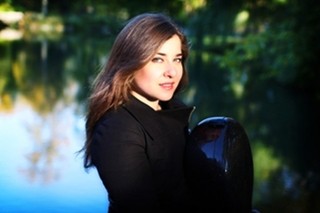|
Back
Rarefied/Rare/Rabid New York
Isaac Stern Auditorium, Carnegie Hall
04/23/2015 -
Igor Stravinsky: Symphonies of Wind Instruments
Dmitri Shostakovich: Cello Concerto No. 2 in G Major, opus 126
Ludwig van Beethoven: Symphony No. 5 in C Minor, Opus 67
Alisa Weilerstein (Cello)
Orchestra of St. Luke’s, Pablo Heras-Casado (Conductor)

P. Heras-Casado (© Richard Termine)
The latest concert by the Orchestra of St. Luke’s had something for everyone. Accordingly, no one would be completely satisfied.
For austere purists, Igor Stravinsky’s spartan Symphonies of Wind Instruments satisfied the brain. For those who didn’t want any difficult challenges, Beethoven’s Fifth was an obvious choice. And those who enjoy near-mystical music-making, Dmitri Shostakovich’s rarely played Second Cello Concerto fit the bill.
No matter what the choice, though, conductor Pablo Heras-Casado continues to amaze. His Orchestra of St. Luke’s wasn’t always up to par (the brass made their fair share of fluffs), but he is one of New York’s best-kept secrets. Not that the world has avoided him, for he has conducted virtually every orchestra in the world, and was rightly called 2014’s Conductor of the Year by Musical America. But when it comes to choices for the next New York Philharmonic conductor, the name Pablo Heras-Casado is rarely mentioned in the first tier.
Yet oh, when taking on Beethoven’s C Minor, he showed motoric force. True, one was astonished that he totally ignored the fermata sign for the E-flat of the opening motive, running his orchestra through Beethoven’s barricade like he was driving in a Grand Prix. Nor did he give the heroic richness to the symphony that, say, James Levine offered with the MET Orchestra last year.
Instead, he turned the Fifth into series of military forays, never pushing or pulling but whipping his orchestra into a series of Napoleonic forays. Did the slow movement lack shading? Well, military campaigns are not knitting circles. Did the celli and basses practically burn their strings getting through the Trio of the Scherzo? That is the sound of battle. For this all led to victorious finale, a victory without regrets.
I wouldn’t want to hear this a second time. It was unique, fire-breathing, and a singular experience which wouldn’t sit well with more traditional conductors. Yet for a one-off experience, one had to give credit to Mr. Heras-Casado for sheer bravado.
This Beethoven finale was the opposite of the opening Stravinsky Symphonies of Wind Instruments, an oftentimes severe paean which the composer dedicated to Debussy. Symphonies has the potential to be played with balletic leaps of imagination, with rhythmic jolts. But Mr. Heras-Casado, a student of Pierre Boulez, hardly saw it in this way. Yes, we had those jolting alterations (not transitions) from ascetical lines to moribund chorales, but Mr. Heras-Casado preferred to avoid anything that could be rendered as “showy”. His winds and brass gave us twelve minutes of pure music, unattached to anything even approximating emotion.
With the right concentration, one could be captivated. Without it, one was a captive.

A. Weilerstein (© Jamie Jung)
Had he wished, the conductor could have followed the Stravinsky with an equally celibate Shostakovich. For while the composer habitually started with a depressing slow movement, the opening Largo here was not depressing: it was cold, chaste, almost a moan.
That, though, was not the way of either Alisa Weilerstein’s cello-playing or Mr. Heras-Casado’s performance. Yes, this was a dark opening, but Ms. Weilerstein let in momentary glaring sunshine, sometimes aggressively fighting with a xylophone, or battling with the bass drum. (The latter giving strokes which could have come out of last week’s Mahler Sixth).
The second movement, which could have had some mordant humor, was actually light, light-hearted. Dedicated to Mstislav Rostropovich, it was also a jokey dedication, which deserves a story.
Apparently at a party one evening, musicians were asked their favorite melody, and Shostakovich took the “low road”. His selection was dirty Yiddish song about a girl selling bagels on the street. Though actually the “bagel” was a euphemism for her own body.
That was worthy of a laugh–but Rostropovich discovered that the composer had used the same bawdy tune for the Allegretto.
The finale was the major surprise, not only of the Concerto but the whole evening. Shostakovich had eliminated trumpets and trombones from the orchestra, but the horns and bassoons gave off with military fanfares, we heard the sound of whips, whisper of dances–and Ms. Weilerstein replying not only with a hard-driven cello, but a reprise of the “bagel song”, this time almost triumphantly.
Unlike the preceding Stravinsky, this was a work which reveled in conspicuous mysteries, jarring exchanges, feverish puzzles. And if these phrases sound self-contradictory, so be it. With artists like Weilerstein and Heras-Casado, words don’t suffice. One sits back and exalts in Shostakovich’s enticing enigmas.
Harry Rolnick
|